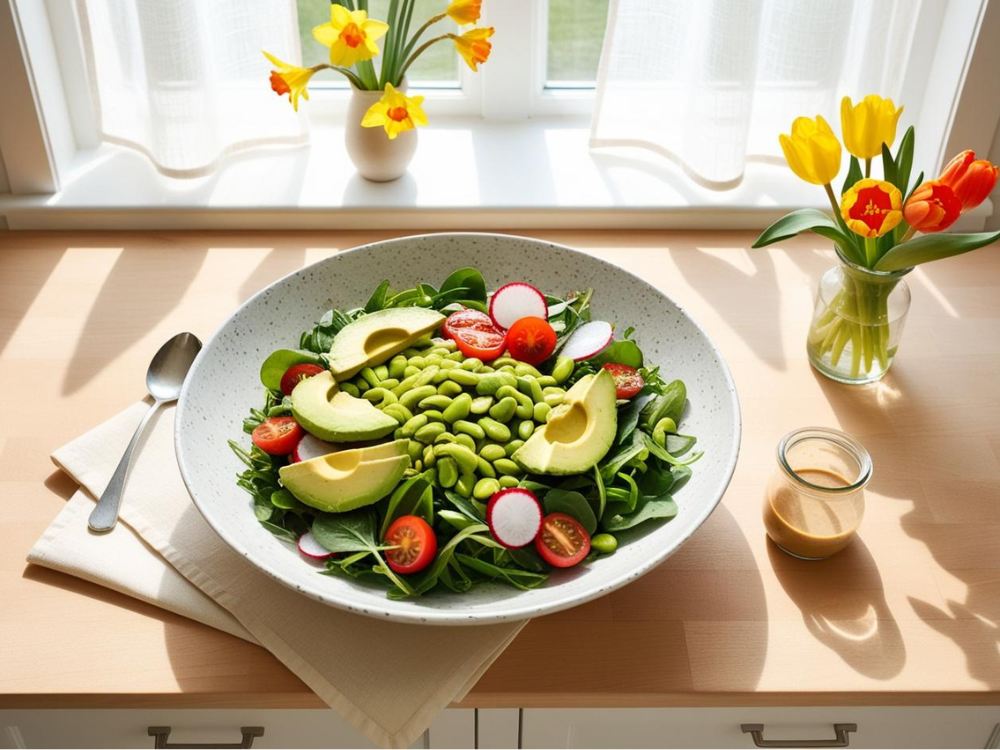Quinoa Veggie Stuffed Peppers
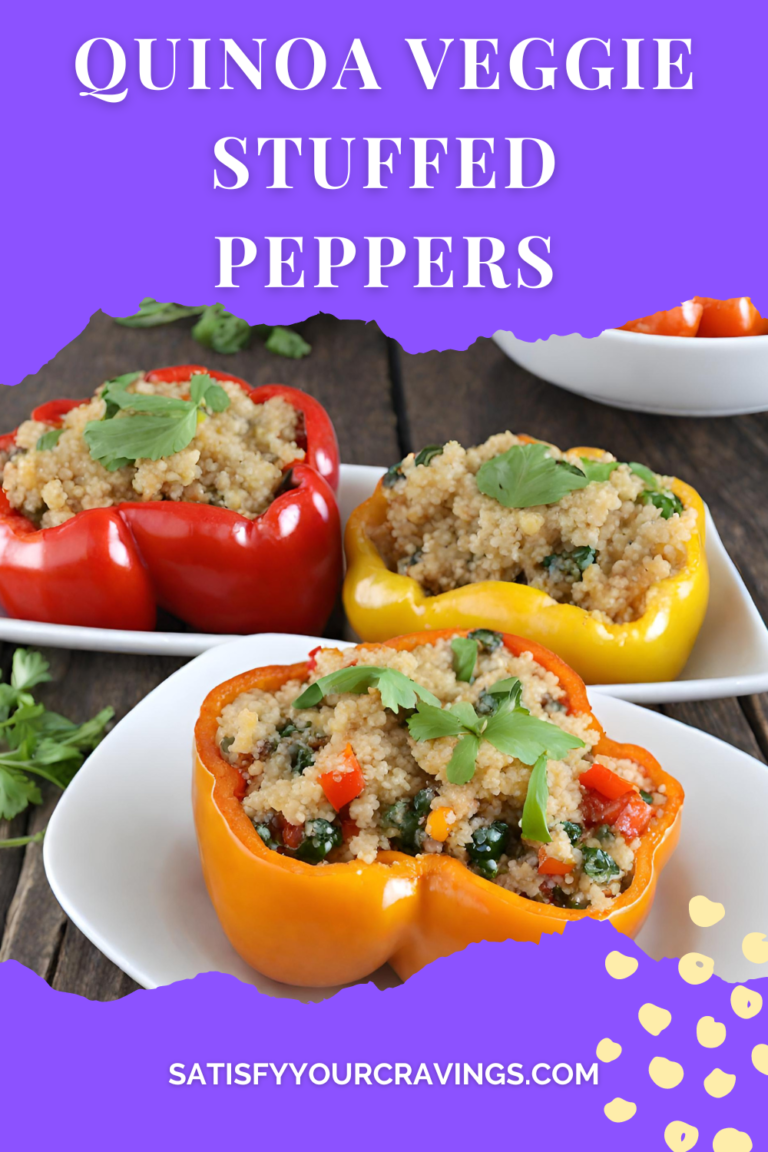
Healthy and Flavorful Quinoa Veggie Stuffed Peppers
Looking for a healthy, flavorful, and easy-to-make dinner option? These Quinoa Veggie Stuffed Peppers are here to save the day! Packed with protein-rich quinoa, black beans, sweet corn, and colorful veggies, this recipe is a feast for the eyes and the taste buds. The bell peppers not only act as a beautiful serving dish but also add a subtle sweetness that pairs perfectly with the hearty filling. Whether you’re cooking for your family, meal-prepping for the week, or entertaining guests, this recipe is guaranteed to impress.
What makes these Quinoa Veggie Stuffed Peppers even better is how customizable they are. Add your favorite veggies, switch up the seasonings, or even top them with vegan cheese for a plant-based twist. They’re naturally gluten-free, vegetarian, and full of nutrients, making them an ideal option for a balanced meal. Plus, they’re easy to prepare, making dinner a stress-free experience. Let’s dive into this wholesome and delicious recipe!
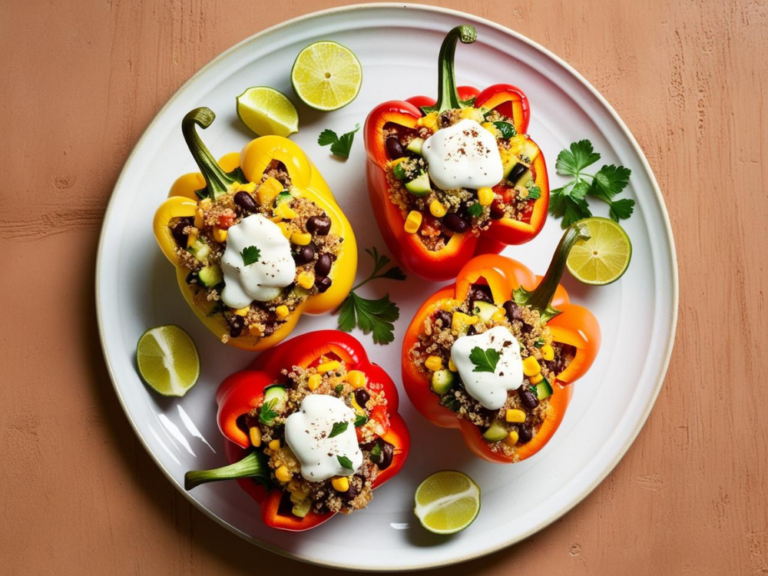
Nutritional Information Breakdown: Why Quinoa Veggie Stuffed
Peppers Are a Healthy Choice
When it comes to finding a recipe that’s both delicious and packed with nutrients, these Quinoa Veggie Stuffed Peppers hit all the right marks. Not only are they bursting with flavor, but they’re also a powerhouse of healthy ingredients that fuel your body. Let’s break down what makes this recipe such a nutritional gem and why it deserves a regular spot in your meal rotation.
A Nutrient-Packed Powerhouse
Each serving of Quinoa Veggie Stuffed Peppers is loaded with wholesome ingredients that offer a wide range of benefits:
Quinoa: Known as a complete protein, quinoa contains all nine essential amino acids your body needs. It’s also rich in fiber, iron, magnesium, and antioxidants, making it a superfood that supports muscle repair, digestion, and overall health.
Black Beans: These little powerhouses are an excellent source of plant-based protein and fiber. They help stabilize blood sugar levels, keep you full longer, and support heart health with their high content of folate, potassium, and magnesium.
Bell Peppers: Packed with vitamins A and C, bell peppers not only add vibrant color to your dish but also boost your immune system. Their natural sweetness balances the savory filling while providing a good dose of antioxidants.
Corn: A sweet and satisfying addition, corn is a good source of vitamins like B-complex and folate. It also adds texture and a touch of natural sweetness to the filling.
Toppings: Depending on your choice, toppings like melted cheese or fresh parsley can add calcium, healthy fats, and an extra flavor boost. You can even opt for a vegan cheese alternative to keep it plant-based.
Nutritional Breakdown Per Serving
While exact numbers may vary depending on your specific ingredients and portion sizes, here’s a general idea of what you can expect per stuffed pepper (without additional toppings like sour cream or extra cheese):
- Calories: Approximately 250–300
- Protein: 10–12 grams
- Fiber: 7–9 grams
- Fat: 5–8 grams (depending on toppings)
- Carbohydrates: 40–45 grams
This balance of macronutrients makes it an ideal meal for those seeking energy, muscle repair, and satiety without feeling heavy or sluggish.
Perfect for Dietary Goals
Whether you’re looking to lose weight, build muscle, or simply eat healthier, these Quinoa Veggie Stuffed Peppers are a perfect fit. Here’s why:
- Low in Calories: Despite being filling, they’re low in calories, making them a great option for calorie-conscious eaters.
- High in Fiber: With fiber-rich quinoa, black beans, and vegetables, this dish promotes healthy digestion and helps you feel full longer.
- Gluten-Free: Naturally gluten-free, this recipe is ideal for those with gluten sensitivities or Celiac disease.
- Rich in Plant-Based Protein: Perfect for vegetarians, this recipe provides the protein you need without any meat.
- Low in Fat: Without heavy creams or oils, this dish remains heart-healthy while still being satisfying.
Adding More Nutrition
If you want to take this dish to the next level nutritionally, here are a few ideas:
- Add spinach or kale to the filling for an extra dose of vitamins and minerals.
- Sprinkle hemp seeds or chia seeds on top for omega-3s and extra protein.
- Swap regular cheese for nutritional yeast for a cheesy flavor without the dairy.
Delicious Meets Healthy
These Quinoa Veggie Stuffed Peppers prove that eating healthy doesn’t mean sacrificing flavor. Whether you’re meal prepping for the week, feeding your family, or simply trying something new, you can feel good knowing you’re enjoying a dish that fuels your body and satisfies your taste buds.
So next time you’re planning a healthy dinner, give these stuffed peppers a try—you’ll love how they make you feel, both inside and out!

Health Benefits of Quinoa Veggie Stuffed Peppers
When it comes to eating healthy, it’s important to choose recipes that not only taste amazing but also nourish your body. These Quinoa Veggie Stuffed Peppers check both boxes, offering a colorful, flavorful meal packed with incredible health benefits. From boosting your energy to supporting overall well-being, this recipe is a true nutritional powerhouse. Let’s take a closer look at why these stuffed peppers are so good for you.
A Balanced, Nutrient-Dense Meal
One of the best things about Quinoa Veggie Stuffed Peppers is how they combine nutrient-dense ingredients to create a perfectly balanced meal. Each component offers its own unique benefits, coming together to support your health in multiple ways:
Quinoa: Often referred to as a “superfood,” quinoa is a complete protein, meaning it contains all nine essential amino acids your body needs. It’s also high in fiber, which promotes healthy digestion and helps you stay full longer. Additionally, quinoa is rich in magnesium, iron, and antioxidants that combat inflammation and support heart health.
Black Beans: These legumes are loaded with plant-based protein and dietary fiber, making them a great addition to a vegetarian or vegan diet. Black beans also contain folate, which supports brain health, and magnesium, which is crucial for energy production and muscle function.
Bell Peppers: Bright, colorful, and naturally sweet, bell peppers are an excellent source of vitamins A and C, both of which are powerful antioxidants. These vitamins support your immune system, promote healthy skin, and improve vision. Plus, the fiber in bell peppers helps regulate blood sugar levels.
Corn: Corn not only adds a touch of sweetness to the filling but also provides a dose of complex carbohydrates, which are your body’s primary energy source. It’s also a good source of B vitamins and essential minerals like magnesium and phosphorus.
Fresh Herbs: Whether you use parsley, cilantro, or another herb, these ingredients add a burst of flavor along with their own health benefits. Herbs are full of antioxidants and can help reduce inflammation in the body.
Supports a Healthy Lifestyle
These Quinoa Veggie Stuffed Peppers aren’t just a treat for your taste buds—they’re a recipe for a healthier lifestyle. Here’s how they can support your well-being:
Rich in Plant-Based Protein
If you’re looking to eat more plant-based meals, this recipe is a fantastic choice. The combination of quinoa and black beans provides ample protein to keep your muscles strong and your energy levels up.High in Fiber
Both quinoa and black beans are rich in dietary fiber, which plays a key role in maintaining a healthy digestive system. Fiber also helps regulate blood sugar levels and keeps you feeling satisfied after meals, making this dish great for those managing their weight.Packed with Antioxidants
The bell peppers and fresh herbs in this recipe are loaded with antioxidants, which help protect your cells from damage caused by free radicals. This can reduce the risk of chronic diseases like heart disease and certain cancers.Low in Saturated Fat
Unlike many comfort foods, these stuffed peppers are naturally low in saturated fat, making them heart-healthy while still delivering on flavor. You can keep them that way by choosing low-fat cheese or skipping it altogether for a vegan option.
Perfect for Special Diets
Another reason to love these Quinoa Veggie Stuffed Peppers is how versatile they are. They naturally fit into several popular diets:
- Gluten-Free: Quinoa is naturally gluten-free, making this recipe perfect for those with gluten sensitivities or Celiac disease.
- Vegetarian: With plant-based protein sources like quinoa and black beans, these peppers are a satisfying vegetarian option.
- Vegan: By skipping the cheese or using a vegan alternative, you can easily adapt this recipe for a fully plant-based diet.
Boost Your Energy and Vitality
Thanks to its nutrient-rich ingredients, this recipe is perfect for boosting energy levels throughout the day. The combination of complex carbohydrates, protein, and fiber provides sustained energy, while the vitamins and minerals from the veggies help you feel your best. It’s a fantastic meal choice for busy weekdays, post-workout recovery, or even meal prep for the week ahead.
A Meal You Can Feel Good About
Eating healthy doesn’t have to mean sacrificing flavor or enjoyment. These Quinoa Veggie Stuffed Peppers prove that nutritious meals can be just as satisfying as your favorite comfort foods. By choosing ingredients that fuel your body and taste amazing, you’re not just preparing dinner—you’re investing in your health and well-being.
So, whether you’re looking to eat cleaner, include more plant-based meals, or simply try something new, these stuffed peppers are a must-add to your recipe rotation. Your body (and taste buds) will thank you!
with a few thoughtful tweaks, you can make it even more sustainable. Here’s how:
1. Choose Locally Sourced Ingredients
Whenever possible, buy your avocados, almond milk, and other ingredients from local farmers or brands that prioritize sustainability. Supporting local agriculture reduces the carbon footprint associated with long-distance transportation.
Tip: Visit farmers’ markets to find fresh, in-season avocados and other produce.
2. Opt for Organic
Selecting organic ingredients like cocoa powder, avocados, and almond milk not only benefits the environment by reducing harmful pesticides but also enhances the nutritional quality of your dessert.
Tip: Look for fair-trade certification on cocoa powder to ensure ethical and environmentally friendly farming practices.
3. Reduce Packaging Waste
Buy ingredients in bulk or from stores that allow you to bring your own reusable containers. This minimizes single-use plastics and reduces waste.
Tip: Check for bulk bins at your local grocery store for cocoa powder, nuts, and other toppings.
4. Use Plant-Based Milk Alternatives
While almond milk is already plant-based, you can go a step further by choosing oat milk, which has a lower water footprint compared to almond milk. It’s equally creamy and works perfectly in this recipe.
Tip: Look for brands that prioritize sustainable farming practices or consider making your own oat milk at home.
5. Swap Maple Syrup for Local Sweeteners
Maple syrup is a fantastic natural sweetener, but if you want to lower your carbon footprint, consider using locally sourced honey (if not vegan) or agave syrup from nearby producers.
Tip: Local sweeteners not only support small businesses but also reduce the environmental impact of long-distance shipping.
6. Use Sustainable Toppings
Choose eco-friendly toppings like organic berries, fair-trade chocolate, or homemade granola. Avoid pre-packaged or overly processed garnishes that come with excess packaging.
Tip: If you’re using nuts, opt for varieties grown in your region to further reduce environmental impact.
7. Compost Your Scraps
Avocado peels, pits, and other kitchen scraps from this recipe can be composted to reduce food waste. Composting helps enrich soil and reduces landfill contributions.
Tip: If you don’t have a compost bin, look for local community composting programs in your area.
8. Go Plastic-Free
Use reusable kitchen tools and storage containers when making and serving this mousse. Glass jars or metal bowls work great for prepping and storing.
Tip: Serve the mousse in reusable ramekins or glasses instead of disposable dishes for a waste-free dessert experience.
Why Sustainable Choices Matter
Making small swaps in your everyday recipes can lead to a big impact on the planet. By incorporating sustainable practices into your cooking, you’re not only enjoying a delicious treat but also contributing to a healthier environment. It’s a win-win for you and the earth!
Have your own sustainable swaps for this recipe? Share your tips in the comments below to inspire others!
Try some of our other recipes!
Ingredient Substitutions and Variations for Quinoa Veggie Stuffed Peppers
One of the best things about cooking at home is the freedom to make a recipe your own. These Quinoa Veggie Stuffed Peppers are incredibly versatile, so whether you’re working with what you have on hand, catering to dietary needs, or just in the mood to experiment, there are plenty of ways to customize this dish. Below, you’ll find a variety of substitutions and variations to help you adapt this recipe to fit your preferences and make it even more delicious.
Swap the Grains
Quinoa is a fantastic base for the filling, but if you don’t have any or want to mix things up, try these alternatives:
- Brown Rice: Adds a chewy texture and nutty flavor, perfect for a heartier dish.
- Farro: A great option if you love a slightly chewy, nutty grain with a high protein content.
- Couscous: For a lighter and fluffier filling, couscous works beautifully.
- Cauliflower Rice: If you’re cutting back on carbs, cauliflower rice is an excellent low-carb substitute.
Switch Up the Protein
The black beans in the recipe add plant-based protein, but you can swap or supplement them with other protein options:
- Chickpeas: Provide a hearty texture and mild flavor that pairs well with the other ingredients.
- Lentils: Cooked green or brown lentils are a great protein-packed option that holds up well in the filling.
- Ground Turkey or Chicken: For a meaty twist, add cooked ground turkey or chicken to the filling.
- Tofu or Tempeh: Crumbled tofu or diced tempeh makes a great vegan protein alternative.
Add More Veggies
One of the joys of stuffed peppers is how easily you can load them up with veggies. Here are some ideas:
- Mushrooms: Diced mushrooms add an earthy flavor and meaty texture.
- Spinach or Kale: Stir in some chopped leafy greens for added nutrients and color.
- Zucchini or Squash: These add a fresh, slightly sweet flavor to the filling.
- Carrots: Finely shredded carrots blend seamlessly into the mixture for a touch of natural sweetness.
Explore Cheese Options
Cheese adds richness and flavor, but you can get creative with your choices or skip it altogether:
- Cheddar or Monterey Jack: Classic options for a gooey, melty topping.
- Feta or Goat Cheese: Add a tangy kick to the filling.
- Vegan Cheese: For a dairy-free option, use your favorite plant-based cheese.
- Nutritional Yeast: Sprinkle some over the top for a cheesy flavor without the dairy.
Spice It Up
Give your Quinoa Veggie Stuffed Peppers a flavor boost by adjusting the seasoning:
- Mexican-Inspired: Add cumin, smoked paprika, and chili powder for a Tex-Mex twist.
- Mediterranean Flavors: Use oregano, basil, and a touch of lemon zest for a fresh and vibrant profile.
- Indian Twist: Stir in curry powder, turmeric, and garam masala for a warm, spiced variation.
- Spicy Heat: Dice up jalapeños, add red pepper flakes, or drizzle with hot sauce for a spicy kick.
Experiment with Bell Pepper Colors
Bell peppers come in a variety of colors, each with its own subtle flavor differences.
- Red Peppers: Sweeter and more vibrant, they’re a great choice for a naturally sweet dish.
- Yellow and Orange Peppers: Milder and slightly fruity, perfect for a balanced flavor.
- Green Peppers: Earthy and less sweet, they add a stronger, savory flavor.
Sauce It Up
Elevate your dish by serving it with a sauce on the side or drizzled on top:
- Tomato-Based Sauce: A simple marinara or salsa pairs beautifully.
- Creamy Sauce: Add a dollop of sour cream, Greek yogurt, or a vegan alternative for creaminess.
- Pesto: A drizzle of basil pesto adds a fresh, herby touch.
- Tahini Sauce: For a nutty and slightly tangy topping, tahini is an excellent choice.
Make It Mini or Family-Sized
Adjust the size of the peppers to suit your serving needs:
- Mini Peppers: Use small sweet peppers for bite-sized appetizers or snacks.
- Large Peppers: Opt for oversized bell peppers for a hearty main course that can serve as a standalone meal.
Bake or Grill
While the recipe calls for baking, you can also prepare these stuffed peppers on the grill for a smoky, charred flavor. Wrap them in foil and place them over medium heat until tender and heated through.
Sweet or Savory Additions
Get creative with unexpected ingredients to take your stuffed peppers in a new direction:
- Sweet Additions: Add a handful of dried cranberries or raisins for a touch of sweetness.
- Savory Touch: Sprinkle in olives, sun-dried tomatoes, or capers for a briny, savory flavor.
Endless Possibilities
The beauty of Quinoa Veggie Stuffed Peppers is their adaptability. Whether you’re working with pantry staples, trying to reduce food waste, or just in the mood to experiment, this recipe can be tailored to suit any taste or occasion. So, don’t be afraid to get creative in the kitchen—your perfect stuffed pepper combination is waiting to be discovered!
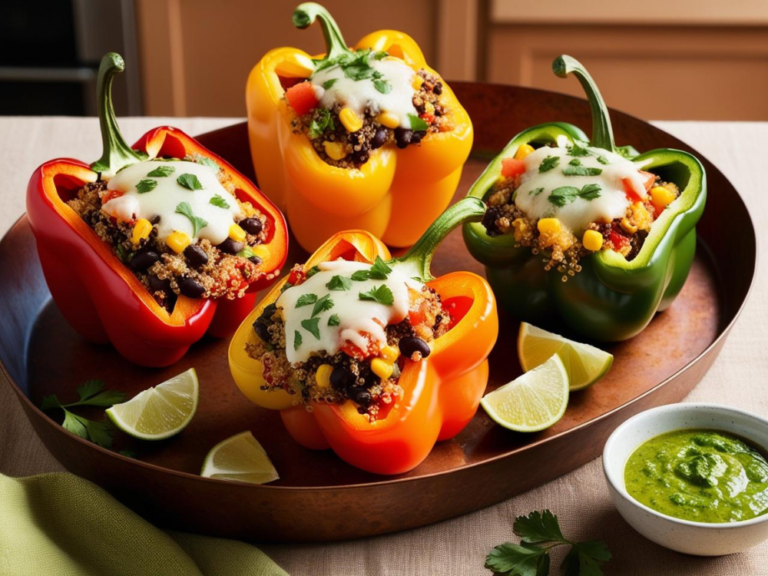
Serving Suggestions for Quinoa Veggie Stuffed Peppers
Quinoa Veggie Stuffed Peppers are a complete and satisfying meal on their own, but pairing them with complementary sides, drinks, or even dessert can take your dining experience to the next level. Whether you’re serving them for a casual weeknight dinner, meal prepping for the week, or presenting them at a dinner party, these ideas will help you elevate the dish into a well-rounded feast.
Perfect Side Dishes
Adding a side dish can enhance the flavors of the stuffed peppers and round out the meal. Here are some great options:
Fresh Garden Salad
A crisp salad with mixed greens, cherry tomatoes, cucumbers, and a light vinaigrette provides a refreshing contrast to the hearty filling of the peppers.Garlic Bread or Dinner Rolls
Warm, crusty garlic bread or soft dinner rolls make the perfect accompaniment, especially if you’re serving the peppers with a tomato-based sauce.Roasted Vegetables
Roasting veggies like broccoli, asparagus, or carrots brings out their natural sweetness and complements the flavors of the stuffed peppers beautifully.Mashed Potatoes or Sweet Potatoes
For a comforting side, serve the peppers with creamy mashed potatoes or a slightly sweet mashed sweet potato for a balance of flavors.Soup
A light soup, such as a vegetable broth or gazpacho, pairs well with the stuffed peppers, especially on cooler evenings when you’re craving warmth and comfort.
Sauces and Dips
Adding a flavorful sauce or dip can make your stuffed peppers even more indulgent. Here are some ideas:
Salsa or Pico de Gallo
A fresh, zesty salsa adds a burst of flavor and pairs wonderfully with the Tex-Mex-inspired filling.Guacamole
Creamy guacamole is a rich and satisfying addition, especially if you’ve added a spicy kick to the peppers.Tahini Dressing
Drizzle some tahini dressing for a nutty and slightly tangy flavor that complements the vegetables.Creamy Yogurt Sauce
A simple sauce made from Greek yogurt, garlic, and herbs like dill or parsley adds creaminess and tang.Hot Sauce
For those who love heat, a splash of your favorite hot sauce or sriracha can elevate the dish.
Beverage Pairings
Pairing the right beverage can make your meal feel even more special. Here are a few suggestions:
Wine
- A light white wine like Sauvignon Blanc or Pinot Grigio complements the fresh and vibrant flavors of the peppers.
- If you prefer red wine, opt for a light-bodied choice like Pinot Noir.
Mocktails or Lemonade
A refreshing lemonade, lime spritzer, or cucumber-infused water pairs beautifully with the dish, especially if you’ve added some spice to the filling.Iced Tea
Unsweetened iced tea or a herbal iced tea like mint or hibiscus provides a refreshing balance to the hearty meal.Beer
A crisp lager or light ale pairs well with the smoky, savory flavors of the peppers.
Dessert Ideas
Finish your meal on a sweet note with these simple yet satisfying desserts:
Fruit Salad
A bowl of fresh, seasonal fruit like berries, melon, and pineapple makes for a light and refreshing dessert.Chocolate Mousse
A small serving of rich chocolate mousse offers a decadent finish without being too heavy.Yogurt Parfaits
Layer Greek yogurt, granola, and fruit for a healthy, satisfying treat that echoes the nutritious theme of the meal.Lemon Bars
The tartness of lemon bars provides a nice contrast to the savory flavors of the stuffed peppers.
Presentation Tips
How you serve your Quinoa Veggie Stuffed Peppers can make all the difference in creating a memorable dining experience. Consider these ideas:
Plating
Serve each pepper on its own plate, garnished with a sprinkle of fresh herbs and a wedge of lime for an elegant touch.Family Style
Arrange the peppers on a large platter, surrounded by sides like roasted veggies or a salad, so everyone can help themselves.Mini Peppers for Appetizers
Use small sweet peppers to create bite-sized versions of the dish, perfect for parties or gatherings.
Meal Prepping with Style
If you’re meal prepping, consider dividing the peppers into individual containers alongside a side like quinoa salad or roasted veggies. This makes it easy to grab a well-rounded, nutritious meal during busy days.
A Meal to Remember
The beauty of Quinoa Veggie Stuffed Peppers lies in their versatility. With the right pairings and presentation, you can turn this simple recipe into a meal that fits any occasion—whether it’s a cozy family dinner, a meal prep masterpiece, or a showstopping party dish. Experiment with these serving suggestions to create a dining experience that’s as delicious as it is unforgettable!
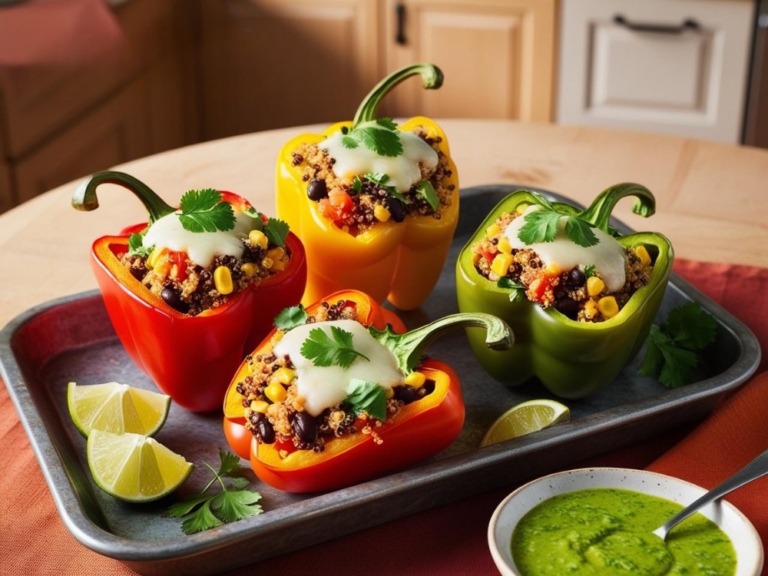
The Cultural and Historical Background of Stuffed Peppers
Stuffed peppers may seem like a simple dish, but their roots are steeped in cultural significance and culinary history. They’re a prime example of how food transcends borders, with variations found in cuisines all over the world. From hearty comfort food to elegant gourmet fare, stuffed peppers have evolved over time, adapting to local ingredients, tastes, and traditions. Let’s explore the rich cultural and historical tapestry behind this beloved dish.
The Origins of Stuffed Peppers
The concept of stuffing vegetables dates back centuries, with early examples appearing in Mediterranean and Middle Eastern cuisine. Vegetables like eggplants, tomatoes, and zucchini were often hollowed out and filled with a mixture of grains, meat, and spices. Bell peppers, native to Central and South America, didn’t become a common ingredient in stuffed dishes until their introduction to Europe in the 16th century, following the Columbian Exchange.
Once bell peppers were integrated into European agriculture, they became a natural choice for stuffing due to their sturdy structure, mild flavor, and ability to pair well with a variety of fillings. The dish quickly gained popularity across Europe and the Mediterranean, where it evolved into the diverse recipes we know today.
Stuffed Peppers Around the World
Each region has its own take on stuffed peppers, showcasing the versatility of this dish. Here’s how different cultures have embraced and adapted it:
Mediterranean
In countries like Greece and Turkey, stuffed peppers are known as gemista or dolma. These versions often feature a mixture of rice, fresh herbs like dill and mint, and sometimes pine nuts or raisins. Olive oil and lemon juice are typically used, giving the dish a light and fresh flavor profile.Central and Eastern Europe
In Hungary, Poland, and other parts of Eastern Europe, stuffed peppers are filled with ground meat, rice, and onions, then cooked in a rich tomato sauce. These hearty versions are often served with a dollop of sour cream, making them a comforting winter dish.Mexico
The Mexican take on stuffed peppers includes iconic dishes like chiles rellenos. Poblano peppers are stuffed with cheese or a meat filling, dipped in egg batter, and fried. They’re often served with a tomato-based sauce for a flavorful, slightly spicy meal.South Asia
In India, bell peppers (known as capsicum) are stuffed with spiced potatoes, paneer, or lentils. These are typically roasted or cooked in a fragrant curry, showcasing the bold and aromatic flavors of Indian cuisine.Middle East
Stuffed peppers in the Middle East are part of the broader family of mahshi dishes, where vegetables are stuffed with spiced rice and sometimes lamb or beef. These are often cooked in a tomato-based broth and served as part of a larger feast.United States
In American cuisine, stuffed peppers often feature ground beef, rice, and cheese, reflecting the country’s love for comfort food. Variations with Tex-Mex flavors, including black beans, corn, and spicy seasonings, are also popular.
The Evolution of Stuffed Peppers
What makes stuffed peppers so enduring is their adaptability. Over the centuries, this dish has evolved to suit changing tastes and dietary needs. Today, stuffed peppers are not only a staple of traditional cuisines but also a favorite for modern twists. From vegetarian and vegan versions to low-carb adaptations using cauliflower rice, stuffed peppers continue to reinvent themselves while staying true to their roots.
Why Stuffed Peppers Endure
The appeal of stuffed peppers lies in their simplicity and versatility. They can be made with inexpensive, readily available ingredients, making them an accessible dish for people across socioeconomic backgrounds. They’re also highly customizable, allowing cooks to experiment with different fillings, seasonings, and cooking methods.
Beyond their practicality, stuffed peppers hold a certain nostalgia for many people. They’re a dish that’s often passed down through generations, with each family adding its own unique spin. Whether it’s a grandmother’s secret spice blend or a modern twist to make them healthier, stuffed peppers are a dish that carries stories and traditions.
Inspiration for Your Kitchen
If you’re making Quinoa Veggie Stuffed Peppers, you’re continuing a culinary tradition that spans centuries and continents. This vegetarian version draws on the global history of the dish while offering a modern, health-conscious twist. By combining nutrient-packed quinoa, black beans, and fresh vegetables, this recipe stays true to the heart of stuffed peppers: a simple yet satisfying meal that brings people together.
A Dish That Brings the World to Your Table
Stuffed peppers are more than just a delicious meal—they’re a celebration of cultural diversity and culinary ingenuity. Every bite connects us to the farmers, chefs, and home cooks who have carried this dish through generations and across borders. So, the next time you enjoy Quinoa Veggie Stuffed Peppers, take a moment to appreciate the rich history and global inspiration behind every flavorful bite.
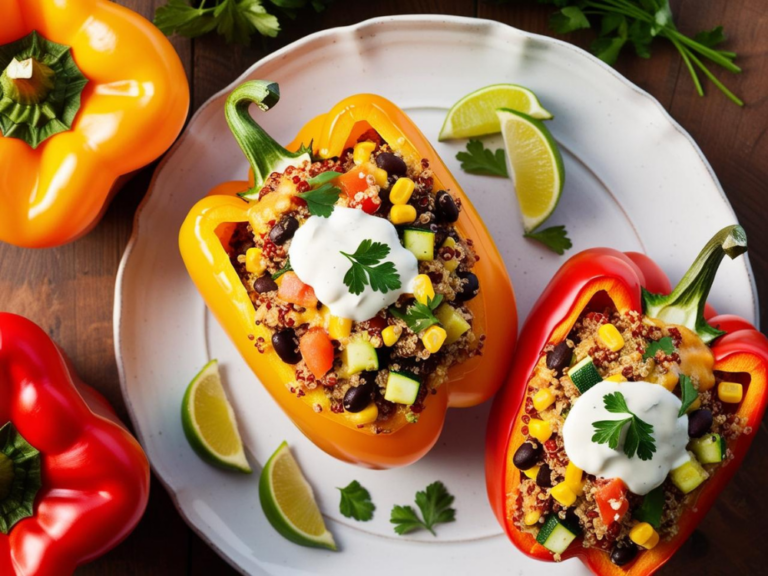
FAQs About Quinoa Veggie Stuffed Peppers
Stuffed peppers are a versatile and delicious dish, but you may have a few questions about making them, customizing them, and getting the best results. Whether you’re a seasoned cook or trying this recipe for the first time, we’ve got answers to some of the most common questions about Quinoa Veggie Stuffed Peppers. Let’s dive in!
1. Can I use different types of peppers for this recipe?
Absolutely! While bell peppers are the most common choice due to their size and natural sweetness, you can get creative with other types of peppers. For a milder option, try sweet Italian peppers. If you like some heat, poblano peppers are a great choice. Mini bell peppers work wonderfully for bite-sized appetizers, and even banana peppers can be stuffed for a unique twist.
2. Can I make these stuffed peppers vegan or dairy-free?
Yes, this recipe is very easy to adapt! Simply leave out the cheese or use a dairy-free alternative, such as vegan shredded cheese or nutritional yeast, for a cheesy flavor. All the other ingredients—quinoa, black beans, and veggies—are already plant-based, so this dish is naturally vegan-friendly with a simple swap.
3. What are some good substitutions for quinoa?
Quinoa is a fantastic base because it’s high in protein and naturally gluten-free, but there are plenty of alternatives if you don’t have it on hand or want to try something new:
- Rice: Brown rice, white rice, or wild rice all work well.
- Couscous: Great for a lighter texture.
- Farro: Adds a nutty flavor and chewy texture.
- Cauliflower Rice: Perfect for a low-carb option.
- Barley: Another hearty grain that pairs nicely with the filling.
4. How do I prevent the peppers from becoming soggy?
Nobody likes mushy stuffed peppers, and the good news is that it’s easy to avoid. Here are a few tips:
- Pre-cook the peppers briefly: Blanch them in boiling water for 2–3 minutes to soften slightly without overcooking.
- Avoid overfilling: Stuff the peppers loosely to allow the filling to cook evenly.
- Don’t add too much liquid: If your filling is overly wet, it can make the peppers soggy. Drain ingredients like canned beans and tomatoes thoroughly before mixing.
- Bake uncovered initially: This allows moisture to evaporate and prevents steaming. If the filling starts to brown too much, cover with foil halfway through cooking.
5. Can I prepare these ahead of time?
Yes, stuffed peppers are a fantastic make-ahead dish! Here’s how:
- Prep the filling: Make the quinoa mixture and store it in an airtight container in the fridge for up to 2 days.
- Assemble the peppers: Stuff the peppers and store them in the refrigerator uncooked. Cover with plastic wrap or foil until you’re ready to bake.
- Freezing option: Assemble the peppers, then freeze them uncooked. To cook, let them thaw in the fridge overnight and bake as usual, adding a few extra minutes to the cooking time if needed.
6. Can I freeze leftovers?
Yes, leftover stuffed peppers freeze beautifully! Here’s how:
- Allow the peppers to cool completely before freezing.
- Wrap each pepper individually in plastic wrap or aluminum foil to prevent freezer burn.
- Place them in an airtight container or freezer bag and store for up to 3 months.
- To reheat, thaw in the fridge overnight and bake at 350°F (175°C) until heated through, or microwave them for a quicker option.
7. How can I make this dish spicier?
If you’re a fan of heat, there are plenty of ways to spice up your Quinoa Veggie Stuffed Peppers:
- Add diced jalapeños or chili peppers to the filling.
- Mix in hot sauce or sriracha for a spicy kick.
- Use pepper jack cheese for a touch of heat in every bite.
- Sprinkle some crushed red pepper flakes over the top before baking.
8. What’s the best way to reheat stuffed peppers?
To maintain the best texture and flavor, reheat stuffed peppers in the oven:
- Preheat the oven to 350°F (175°C).
- Place the peppers in an oven-safe dish, cover with foil, and bake for 15–20 minutes or until heated through.
For a faster option, you can microwave them, but the peppers may become softer.
9. How can I make these stuffed peppers kid-friendly?
Kids can be picky eaters, but stuffed peppers can be a hit with a few adjustments:
- Use mini peppers for smaller, fun-sized portions.
- Add extra cheese to the filling to make it more appealing.
- Keep the seasonings mild—avoid anything too spicy.
- Serve them with a side of dipping sauce, like ranch or ketchup, to make them more exciting.
10. Can I serve these stuffed peppers as a side dish instead of a main course?
Definitely! To serve as a side dish, use smaller peppers or cut the larger peppers into halves or quarters before stuffing. Pair them with grilled chicken, fish, or a hearty soup for a well-rounded meal.
11. What’s the best way to ensure the filling is flavorful?
The key to a flavorful filling is seasoning at every step:
- Cook the quinoa in vegetable broth instead of water to infuse more flavor.
- Add plenty of herbs and spices, such as garlic, cumin, paprika, or fresh parsley.
- Taste the filling before stuffing the peppers and adjust the seasonings as needed.
A Dish Made for Everyone
The beauty of Quinoa Veggie Stuffed Peppers lies in their versatility and adaptability. Whether you’re customizing the recipe to suit your tastes, making them ahead of time, or experimenting with creative substitutions, this dish is a winner every time. With these FAQs, you’re all set to master the art of stuffed peppers and enjoy a meal that’s as delicious as it is customizable!
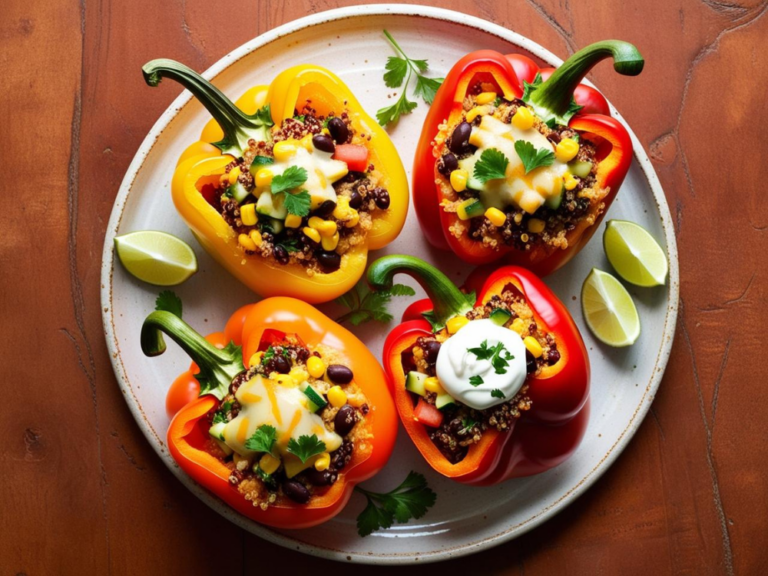
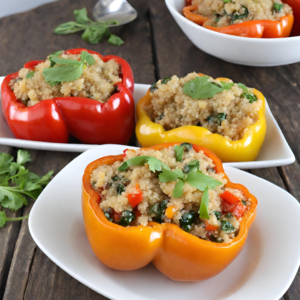
Quinoa Veggie Stuffed Peppers.
Equipment
- Large Baking Dish: To arrange the stuffed peppers while they bake.
- Medium Saucepan: For cooking the quinoa or your chosen grain.
- Cutting Board and Knife: To slice the tops off the peppers and chop vegetables.
- Mixing Bowl: To combine the filling ingredients.
- Wooden Spoon or Spatula: For stirring the filling evenly.
- Aluminum Foil or Lid: To cover the baking dish while cooking (optional for preventing dryness).
- Measuring Cups and Spoons: For accurate measurements of quinoa, seasonings, and other ingredients.
- Colander or Strainer: To rinse quinoa and drain black beans or corn.
- Oven Mitts: To safely handle the hot baking dish.
- Serving Utensils: A large spoon or tongs for serving the peppers.
Ingredients
- 4 Large bell peppers (a mix of colors)
- 1 Cup Quinoa (rinsed)
- 2 Cups Vegetable broth or water
- 1 Medium onion, finely chopped
- 2 Cloves garlic, minced
- 1 Zucchini, diced
- 1 Carrot, diced
- 1 Cup Corn kernels (fresh or frozen)
- 1 Can (15 oz) black beans, drained and rinsed
- 1 Tsp Cumin
- 1 Tsp Paprika
- Salt and pepper to taste
- 1 Cup Shredded cheese (cheddar or your choice)
- Olive oil
- Fresh cilantro for garnish
Instructions
- Begin by preheating your oven to 375°F (190°C). Slice the tops off the bell peppers and remove the seeds and membranes. Brush the outsides with olive oil and set aside.
- In a saucepan, combine the quinoa and vegetable broth. Bring to a boil, then reduce heat, cover, and simmer for 15-20 minutes, or until the liquid is absorbed. Fluff with a fork.
- While the quinoa cooks, heat a splash of olive oil in a skillet over medium heat. Add the onion and garlic, sautéing until fragrant. Toss in the zucchini and carrot, cooking until slightly soft. Stir in the corn, black beans, cumin, paprika, salt, and pepper. Cook for another 5 minutes.
- Mix the sautéed vegetables with the cooked quinoa. Adjust the seasoning to your taste.
- Fill each bell pepper with the quinoa mixture and top with shredded cheese.
- Arrange the peppers in a baking dish and cover with foil. Bake for about 30 minutes. Uncover and bake for an additional 10 minutes, or until the cheese is bubbly and golden.
- Let the peppers cool slightly, then sprinkle with fresh cilantro before serving.
Notes
Make-Ahead Instructions
-
Prepare the Filling in Advance:
- Cook the quinoa and mix it with the black beans, corn, veggies, and seasonings up to 2 days ahead of time.
- Store the filling in an airtight container in the refrigerator.
-
Assemble the Peppers:
- Hollow out the peppers, stuff them with the prepared filling, and arrange them in a baking dish.
- Cover the dish tightly with plastic wrap or aluminum foil and refrigerate for up to 24 hours before baking.
-
Freezing for Later:
- Assemble the peppers as directed but do not bake. Wrap each stuffed pepper individually in plastic wrap or foil, then place them in a freezer-safe bag or container.
- Store in the freezer for up to 3 months.
Storage Instructions
-
Refrigerating Leftovers:
- Allow the cooked peppers to cool completely before storing.
- Place them in an airtight container and refrigerate for up to 4–5 days.
-
Freezing Leftovers:
- Wrap cooled stuffed peppers individually in plastic wrap or foil, then transfer them to a freezer-safe bag or container.
- Freeze for up to 3 months.
Reheating Instructions
-
From the Refrigerator:
- Preheat your oven to 350°F (175°C).
- Place the peppers in a baking dish, cover with foil, and bake for 15–20 minutes or until heated through.
- Alternatively, reheat in the microwave on medium power for 2–3 minutes per pepper, checking for even heating.
-
From the Freezer:
- Option 1 (Thawed): Let the peppers thaw in the refrigerator overnight, then reheat as directed above.
- Option 2 (Frozen): Place the frozen peppers in a baking dish, cover with foil, and bake at 375°F (190°C) for 30–40 minutes, or until heated through.
Tips for Best Results:
- If freezing, consider leaving off the cheese topping and adding it fresh when reheating for better texture and flavor.
- For added freshness, garnish reheated peppers with freshly chopped herbs, a drizzle of sauce, or a squeeze of lime before serving.
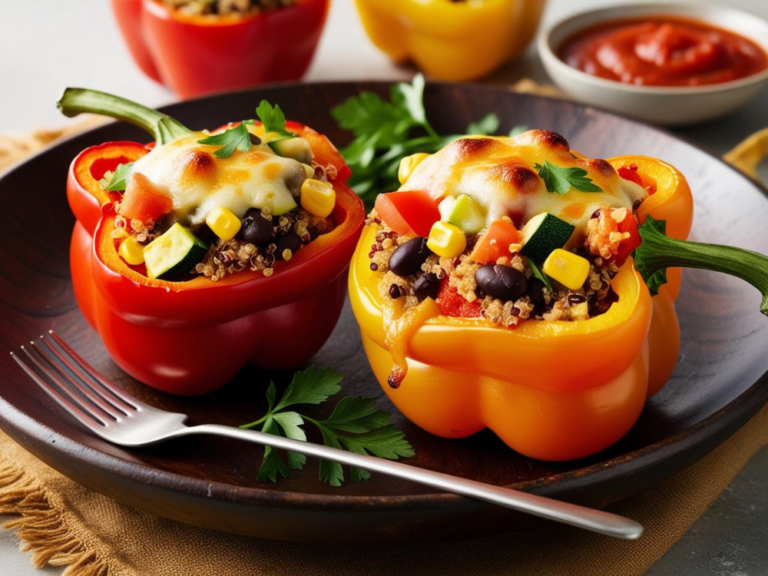
A Wholesome Meal to Savor
There’s something truly special about a dish like Quinoa Veggie Stuffed Peppers. It’s more than just a recipe—it’s a celebration of vibrant, wholesome ingredients coming together to create a meal that’s both nourishing and delicious. Whether you’re enjoying them fresh out of the oven, prepping them for a busy week, or sharing them with family and friends, these stuffed peppers are a reminder that healthy eating can be simple, satisfying, and full of flavor.
As you take that first bite, you’ll taste the care and thoughtfulness that went into every ingredient. From the protein-packed quinoa to the fresh vegetables and flavorful seasonings, this recipe is all about fueling your body and delighting your senses. Plus, it’s incredibly versatile, giving you endless ways to make it your own.
So, whether you’re a seasoned cook or just starting your culinary journey, this recipe is an invitation to slow down, savor the moment, and enjoy the magic of a home-cooked meal. Give these Quinoa Veggie Stuffed Peppers a try—you’ll not only love how they taste but also how they make you feel. Happy cooking!
Join Now!
Love this recipe? Don’t miss out on even more delicious, healthy, and easy-to-make recipes like this Quinoa Veggie Stuffed Peppers! By joining our email community, you’ll gain access to exclusive content, bonus recipes, and tips to make clean eating a breeze.
Enter your email & click below to subscribe and start receiving tasty inspiration right away. It only takes a minute to join our growing community of food lovers dedicated to making healthy eating delicious and fun.

